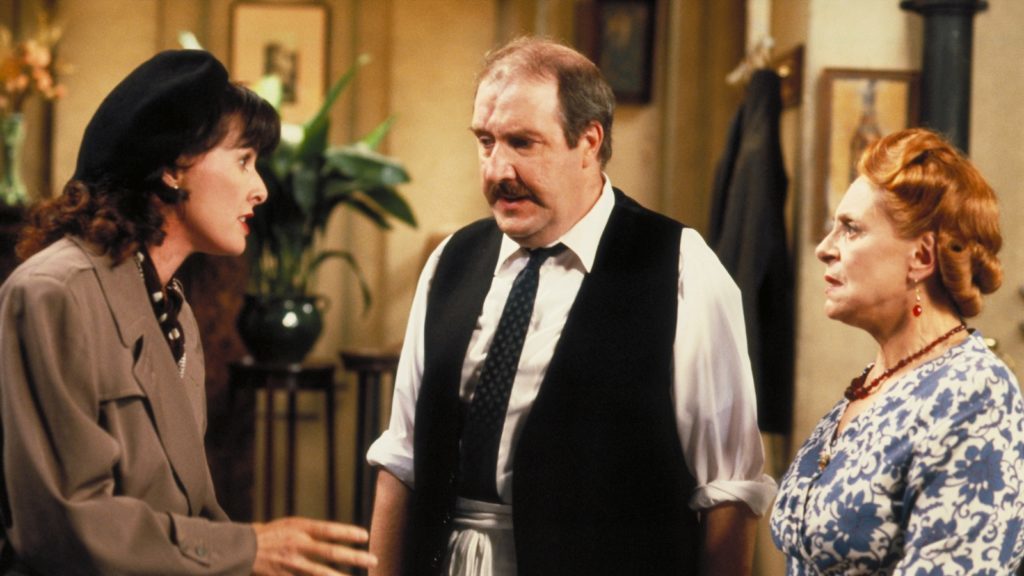by Rachel O’Toole
I couldn’t find any model or pattern that I could apply while learning to be a coach. Instead, a model emerged out of my growth as an agile coach. It is based around six different personas that I inhabit when I’m in different types of situations with individuals, groups, and teams. Because there are six distinct personas to the model, I call it The Persona Cube. The personas are helpful because I tend embrace the part I’m playing wholly which helps to straying into problem-solving mode as that would mean breaking character. This allows me to get out of the way of the people I’m coaching to ensure that they can solve their own problems making the learning or change they want more likely to stick.
Now to meet the six personas.
Coaching Persona #1: The Inquisitive Child

This was the first persona I worked on with any degree of awareness and I was foolish enough in those early days to think that this might be the only one I’d need. It was and still is one of the harder ones to master simply because I tend to want to jump into solution-mode just to move an issue along.
For the Inquisitive Child Persona, I took my inspiration from my toddler son, a master of powerful questions. He easily mastered Sakichi Toyoda’s Five Whys technique, which I didn’t put to good use until my 30s. Every conversation with him usually ends in at least a few rounds of Why. I noted that he is not ashamed that he doesn’t know the answer and instead is thirsty to learn all that he can through that simple three letter word. Each of these Whys forces me to think before giving an answer, and the more Whys he adds to the conversation, the harder it is not to default to the parent mantra of “Because I said so.” Clearly, there are times where I need to go and learn something to be able to address his Why or there are some Whys I don’t yet want to explain, but the fact that he has asked always forces me to think.
This persona is recognised by the fact that it comes about when an individual or team approaches me with a problem, looking for guidance and support as to how to solve it. I don’t want to create a reliance on me to solve issues for a team so I use the Five Ws and One H technique, an extension of the Five Whys technique to drive the conversation. The structure used to drive the conversation is as follows:
- Ask permission to coach
- Focus on understanding current issue and its impact
- Gain positivity and insight by delving into how it has impacted them and what would happen if the issue were to be resolved
- Explore options that would resolve the issue
- Ask what are the next steps that can be taken
- Get coachee to pick an action plan and hold them accountable by arranging a follow up
The questions I ask are often perceived as simplistic and even stupid because they are framed around what, how, why, when, where, who. Such open questions avoid us getting into playing what I call “The Yes/No Game Show” as it can result in the people in the room becoming bored, me doing all the talking, or worse still the people becoming defensive and taking an adversarial position against me.
Recently a Scrum Master approached me because of an issue on his team. It was clear from the outset that he felt frustrated. While he walked me through his current thinking on the problem at hand, issues with the interactions in the team surfaced. The coachee, however, felt the format of a particular meeting was the problem so we stayed in the gaining insights part of the conversation delving deeper into the reasons why that meeting was difficult. The struggle with such discussions is that my frustration with the circular nature of the conversation may result me me highlighting what I think to be the root cause rather than the coachee doing so. Patience is required to continue to just ask the questions and either let them come to a conclusion on the root cause themselves or recognise that the coachee may not be ready to face the real issue at hand just yet. In this instance he realised that there was an individual pulling the team performance down.
Once he came to that conclusion the conversation became about looking for a positive and professional solution to address the issue at hand. The action plan forward where a person’s behaviour is driving a negative behaviour in others is never easy and needs to be sensitive to the needs of all parties. In this instance the logical conclusion was for the coachee to call in the support of his line manager to address, which resulted in a positive outcome for all involved.
I spent several months blissfully unaware of the fact that I was relying too heavily on this persona thinking that I had nailed my coaching approach. Due to my over reliance on this, workshops I facilitated were becoming stale so a new persona needed to be developed to ensure people stay motivated and interested. And that is how the PE Teacher persona came into being.
Coaching Persona #2: The PE Teacher

When I was in school I had a physical education teacher, Miss O’Donnell, who scared every one of us in her class. She was full of energy and could make her voice carry across continents. She was excellent at getting us to do whatever exercise plan she had dreamed up so that we could keep our heart rate in the cardio zone and be fully engaged with the activity. During these sessions, she had a knack of knowing when we were losing interest and would throw away the lesson plan she probably put a lot of work into so that the goal of the activity — which was to keep our heart rate up — was achieved. I never saw her as a role model while I was in school; instead she was someone out to annoy me and test my allergy to exercise. However, since I moved into training, I’ve channelled my inner Miss O’Donnell to ensure the goal of a workshop is met without getting too hung up in the process used to achieve it. To quote Dwight D. Eisenhower, “In preparing for battle I have always found that plans are useless, but planning is indispensable.” That sums up The PE Teacher Persona quite well.
A lot of preparation goes into the setup workshops and training, and the timings on the day are worked out to be shared in advance with the people asking for my services. When the workshop is being run, the communication style is kept directive and authoritarian. I demand feedback frequently during the session to ensure the group are still on track to meet their goals while also watching out for signs of fatigue and boredom in the group. I keep moving all day and don’t drop my energy so that they can feed off my energy. A critical part of the day is moving the attendees towards meeting the course or workshop objectives. To do that, I must be willing to ditch the very carefully detailed lesson plan or agenda to ensure the attendees get value from the events. It took me some time to free myself of the structure and work in this manner as those plans were my security blanket. I like to see the plan I have put in place be executed as I have envisaged, but after some very valuable feedback from a team I worked with I was realised I had to do this. If there is no engagement from the group after a few switches in the process I will pause the session and give the attendees the opportunity to cancel the day and get back to their day jobs as it is them that must get the value from such events and not me.
Recently, I have been delivering training to groups of developers on user story writing and effective planning, originally involving theory-heavy modules to be delivered over a couple of days. The first day was exhausting for all of us because of all that theory. I was worried as there was more to be covered on the following day too. I, and more importantly the attendees, were going to face yet another substantial day of learning. I spoke with an attendee about my concerns around the theory and he reflected that it was going to be tough to retain the learnings from that day, let alone face into another day. The evening was spent reading blog posts and excerpts of books to figure out how to keep the energy up and to deliver the training in a manner that would stick. After a very late night, I put together a Lego exercise to simulate the theory we had not covered as well as including the theory we had already covered to reinforce the learning. Lego exercises are a bit of a cliché for agile coaches so I had previously tried not to use them.
After asking myself, “What would Miss O’Donnell do?” I realised I had to embrace the activity and run with it. The day was still exhausting but the learnings were easier for the attendees. Throwing away the structure of training is hard to do because the objectives, at least on paper, will be met if I follow what I have spent time coming up with. But doing what works for my coachees goes back to me resetting myself against what is the expected outcome of the day and what is the best way to achieve that in the moment.
Both the PE Teacher and the Inquisitive Child are very structured sessions. There are times where I need to be less structured and overt in my approach to attempting to change an organisation in transition. The Resistor Persona was borne out of my desire to positively alter the culture of the organisation I work for.
Coaching Persona #3: The Resistor

Growing up, I loved the program Allo Allo. It’s a British comedy that is set in an occupied French village during the Second World War. It’s irreverent humour and the feeding into stereotypes was, and still is, exceptionally funny to me. There is something so wrong about the program that is so right. My favourite character was Michelle of the Resistance and every time she appeared she would say “Listen very carefully, I shall say this only once.” The Resistor Persona is derived from this simple premise. I will try to plant a seed or idea once and, if it fails, there are plenty other avenues to affect change in my workplace.
I use this persona when I have tried other more direct personas to get a working practice or message that I strongly believe in, but which has not succeeded. There are always other less direct avenues to get my message across because it is focussed on process, product, or organisational improvement and planting that idea for other people to carry it is very effective. I never really get any visibility of whether the message was carried successfully and will go to many sources to push through so that the product or process benefits. Often the many lone voices who speak about an improvement can create the change needed in the organisation. This is never used for personal gain, as, once I have given the idea over to someone else, I step back from it and let them drive it. If the other person or people succeed where I have failed, then they rightly get credited with it.
Sometimes in the agile world, we can forget to effectively plan roadmaps and live in the moment, just planning sprint on sprint. This short-termism can mean that we never really know what we are building towards or why we are doing what we are doing. In one project, longer-term planning of the roadmap for the product was being done at a high level and the teams that developed the product were planning sprint on sprint with no real awareness of the overall roadmap. I spent time putting together a process and presented in the lecture theatre space on-site. Very few took the practice from that meeting and applied it, meaning that the disconnect between the product roadmap and team planning was still there. It also highlighted the fact that my communication had failed. My next approach was to find “friendly” Product Managers who manage the prioritised backlogs of requirements for our products to give the idea to. They were open to trying to plan for longer than a sprint so they could understand how much they realistically could do in a particular timeframe and better help prioritise the work. We spent time in the background putting together the process and trained one Project Manager in the technique before I stepped back completely. They applied it across a release and it was spoken about by the team to others and likewise by the project manager to her peers. It took 6 months to effectively embed the process in a large-scale project of over 100 teams but it was in wide use by the end. The Product Manager, development team and Project Manager had succeeded where I had failed and the gap between the roadmap and what the teams planed was bridged.
Using this technique will only ever yield results when it is used for the good of a program, project, or process. It is an indirect approach and one that generally takes time, however, if I feel it is worth investing in, I am willing to put in the work in the background to make it happen.
While I was perfecting this persona more and more Project Managers wanted support in rolling out the release planning process. I realised that often the same people came back looking for training and support time and again without actually learning how to apply the process themselves. They were happy to pay lip service to employing the process without any follow through, and thus the Disappointed Parent was born.
Coaching Persona #4: The Disappointed Parent

Every one of us have at one-point borne witness to the hurt, disappointed look of a parent that is worse somehow than when they are annoyed with us. It’s compounded when they utter the words “I’m not mad, I’m just disappointed.” When I had my own son, I didn’t set out to use it but that changed over time. Once at a playgroup he pushed over another child who wouldn’t share a toy. I was horrified and the disappointed parent look spread across my face without me even realising. He looked over towards me to see if I witnessed the incident and how much trouble he was in; normally if I’m annoyed he would laugh and do the Peppa Pig “It’s a little bit funny” line and would make me laugh too. When he saw my face, he burst into tears and ran at me shouting “Don’t be disappointed!” It wasn’t the first time the look had been used but it was the first time he had reacted so terribly to it and it has set the tone since of how he reacts when, on the rare occasion, I’m genuinely disappointed.
In a work setting, clearly, it doesn’t have the same reaction as it does with my son. The Disappointed Parent Persona is used when either training has been given or a coaching conversation has been had but there has been inertia on the part of the team or individuals who have received the support. One example of when it was used in training is that during 2016 I was tasked with ensuring there was a code review process in a product we were developing. I spent time bringing expertise together and researching the best course of action. We used a pre-existing code review process and went speaking to the teams, leveraging their line managers to help deliver the workshops to their teams. We all walked away patting ourselves on the back thinking our jobs were done. Months later while delivering another course using the exact same slides, people in the room seemed really engaged. This surprised me as I had assumed we wouldn’t be covering it in too much detail; instead we spent almost two hours discussing the process. The moment of clarity came when one person on the course said that they wished they had the process the year before. I went straight into Disappointed Parent mode and reminded them about the previous workshops in 2016. Nobody wants to be scolded for not doing something that they agreed to do. The discomfort created by using this persona caused the individuals to introspect and discuss why they had chosen to ignore the good advice given the previous year. They all agreed that this was a critical process so we didn’t need to discuss it further and instead time was spent on each of the reasons put forward for not taking it on board. Ultimately the individual’s resolved to take the process on board and their desire to not fail this time resulted in the process being used much more widely than it had been previously.
The Disappointed Parent is used to show my displeasure at someone not taking on board the support I have offered either in training or during a coaching session. There are times, however, when it would be necessary to shield others from from my true opinions and the next persona, The Stepford Wife, is about hiding how I really feel from my colleagues.
Coaching Persona #5: The Stepford Wife

In 1972 Ira Levin wrote a novel called The Stepford Wives and the household term was born. In a home context, it is used to describe a submissive and docile wife who serves her husband’s every whim and in work it is used to describe a meek person who submits readily to authority.
This is the least enjoyable persona because it is so unlike me and if I am using this persona I feel I have failed to execute my role effectively. I don’t believe in being a “Yes sir, no sir, three bags full sir” person but there are times, to protect a relationship or to ensure I remain professional that this must be employed.
It was most recently used during a meeting where I was presenting the 2017 strategy for coaching. The meeting went downhill from the outset. Although I tried to recover, after a couple of paths failed, I made the decision to just put on my Stepford Wife smile and agreed with all that was said simply to end the conversation. There was no point in trying to progress the meeting as I had lost the group and it was degenerating to an adversarial “he said/she said” argument. Using the technique of agreeing allowed the conversation and meeting to end so that I could regroup and decide how to deal with the issues that I felt of strategic importance going forward.
Coaching Persona #6: The Psychologist

Becoming an agile coach has been a journey of self-discovery and I have a high degree of self-awareness as a result. However, there are still parts of me that I lock away from myself and I was not aware of The Psychologist and its value to others until I spoke about the model with my colleagues, who highlighted the absence of this one, even though I have done this since my early days as an agile coach. My colleagues chose the name Psychologist as they feel I evaluate company culture and climate for the overall well-being of projects and programs and, sometimes, the wellbeing of my colleagues. This is largely applied on an ad-hoc basis and normally comes from one simple question: “How are you?”, followed by taking the conversation to a small meeting room on-site which we call quiet rooms. I refer to them as the confessional because often in those quiet rooms a person can share some of their more private thoughts that they wouldn’t necessarily like many work colleagues to know. Here I invoke the Rule of Coach Club — . you do not talk about coach club — in order to create a safe space for people to share. Although this is one that I have done from the very beginning and engage in on an average of once a week there are no examples that I can talk about because of this rule. The neuroscience-based coaching course has heavily influenced my approach to these sessions and are the purest form of coaching I do, acting as the conversational mirror I spoke about earlier.
Read on: Why Management 3.0 is essential for Agile Coaches
And a coach was born
Becoming a coach has been quite a journey. Watching an organisation transition through to a more agile development process has forced me to change and adapt how I work with people to help bring about change. There is no silver bullet to address change on an organisational scale. In fact, the same could be said for people. It is inherently difficult to move from one way of viewing the world to another. To quote Sir David Brailsford when talking about the success of the Sky cycling team, “It is about marginal gains… The approach comes from the idea that if you break down a big goal into smaller parts, and then improve on each of them, you will deliver a huge increase when you put them all together.”
These six coaching personas follow the same path, as I have broken the diverse aspects of my job into smaller parts and developed a variety of approaches depending on the circumstances. My role as an agile coach is about giving people space to improve the so-called small parts that they have control over and letting each of these accumulate to create change at an organisational scale. Having different skills to call upon allows me to fail safely as there is always another persona to try when one approach fails.
We are still an organisation in transition but we are farther down the path to working with agility than sometimes we even realise. Like the organisation I work for, I now realise that I am also in transition in terms of who I am, and this role has allowed me the time and space to figure out the journey I am on.
The fact that my becoming an agile coach has resulted in the development of The Persona Cube is a great side effect of the journey I am on. The Persona Cube gave me the “How to be a good agile coach” blueprint I was looking for in the beginning. In fact, I now realise that it is the people and not the processes that are critical to the success of any change being introduced in an organisation. Having a model that rightly focusses on giving individuals the headspace to think and learn keeps any organisation moving forward when they are trying to transition to new ways of working.
My name is Rachel, and I’m now proud to say I’m an Agile Coach.
This is the second part in a series. Definitely check out the start of Rachel’s journey in “How I became an accidental agile coach.”
Photo by Rawpixel, Unsplash

